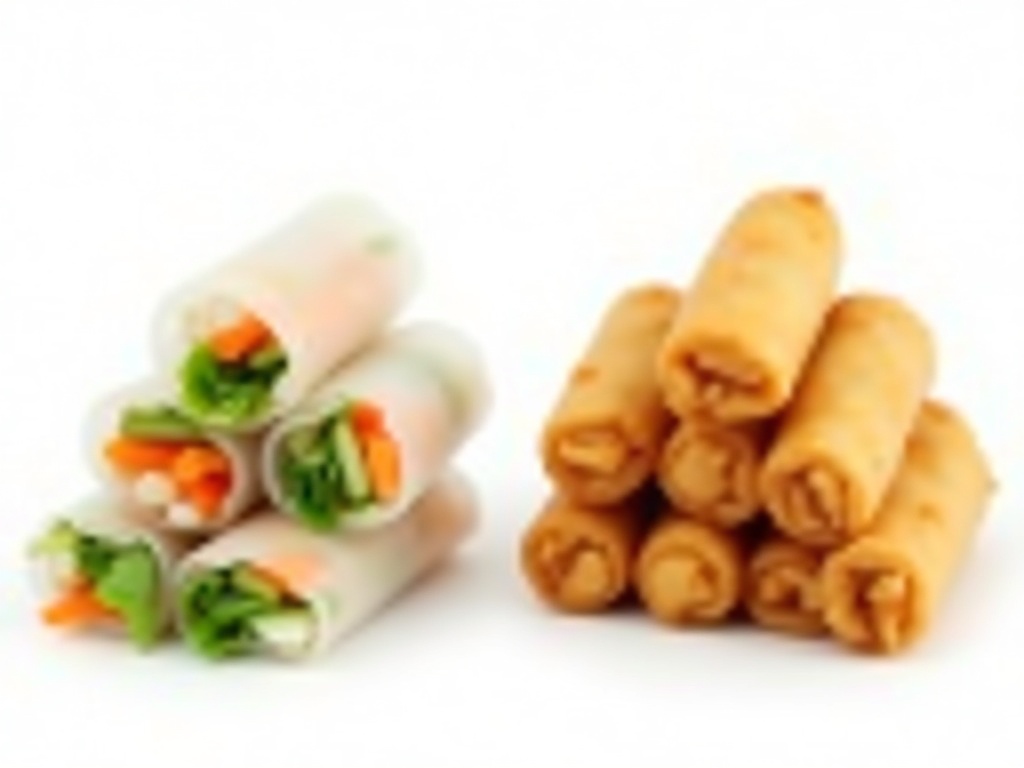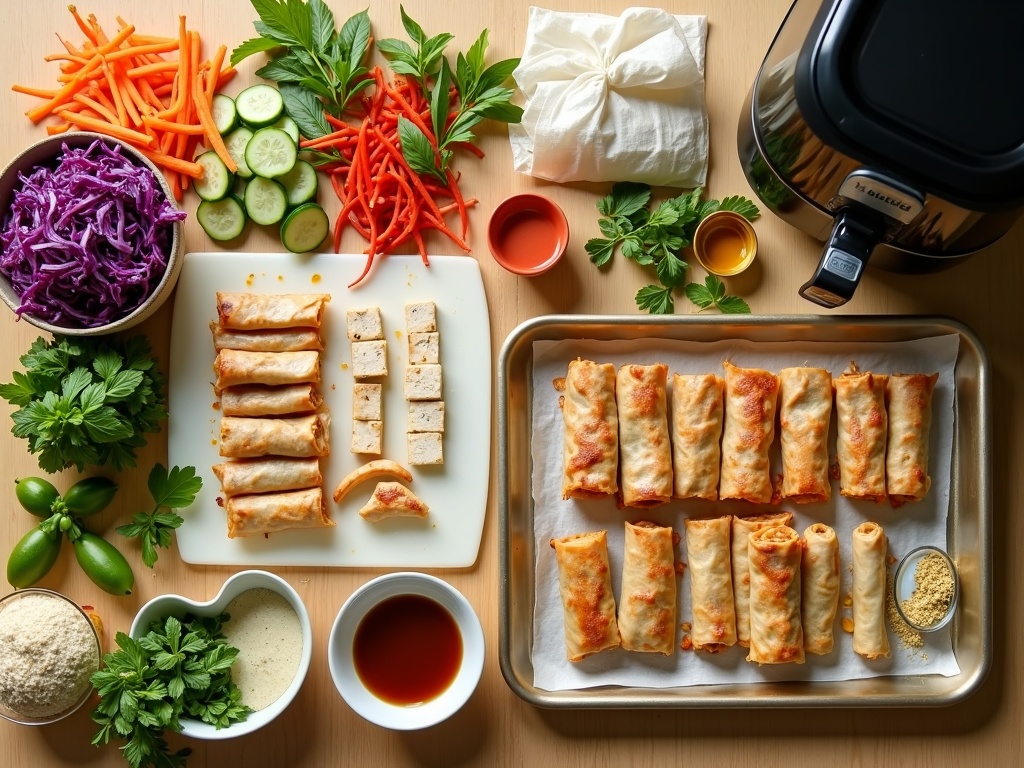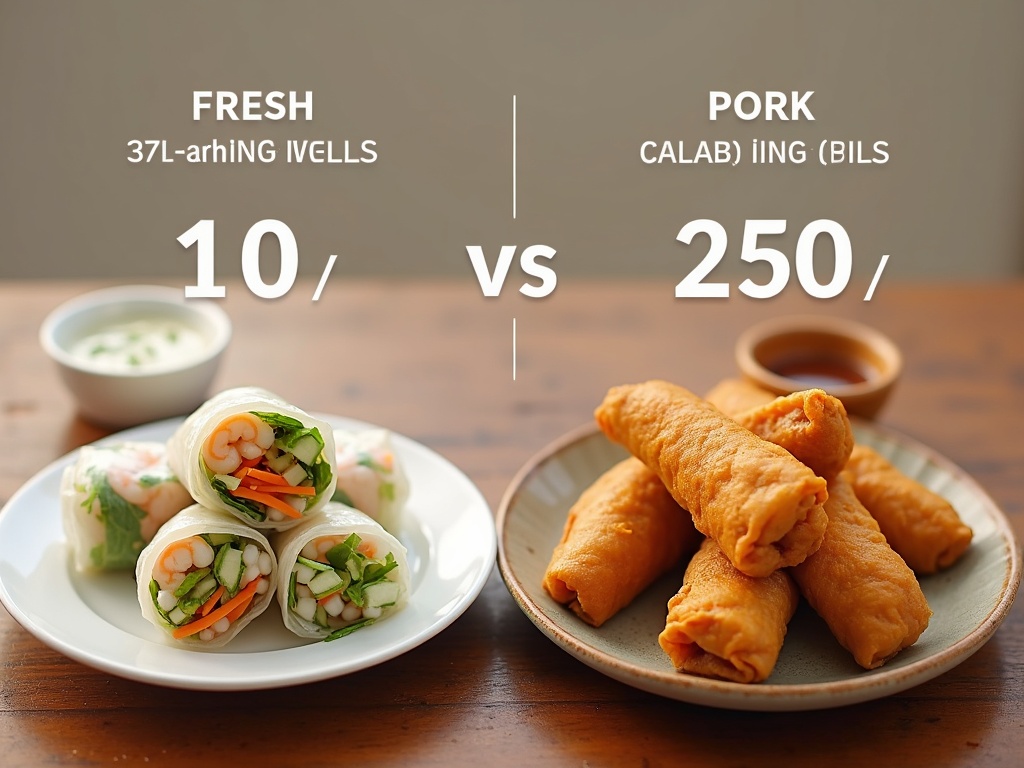Spring roll calories range dramatically from 80 to over 350 calories per piece, with the preparation method serving as the primary determining factor in this significant caloric variation.
Calorie Comparison of Spring Rolls
Fresh spring rolls typically contain 80-150 calories each, while deep-fried versions can soar to 150-350+ calories. This represents a potential 200-300% increase in caloric content depending on how they are cooked. The caloric disparity emphasizes how important the cooking technique is in determining the nutritional value of these popular appetizers.
Key Takeaways
- Fresh spring rolls: 80-150 calories per piece; fried ones: 150-350+ calories — illustrating how preparation method significantly affects calorie content.
- Dipping sauces can add hidden calories. For example, peanut sauce may contribute 90-120 calories per 2-tablespoon serving and can potentially double your caloric intake.
- Air frying or baking can reduce calories by about 85 per roll compared to deep frying, while still providing a satisfying texture and crunch.
- Ingredient swaps like substituting vermicelli noodles with julienned vegetables can save nearly 50 calories per roll without sacrificing flavor or satisfaction.
- Restaurant spring rolls are usually larger and higher in calories than homemade ones — some may contain over 400 calories per roll.
If you’re looking to make spring rolls at home in a healthier way, consider exploring air-fried or veggie-based alternatives and be mindful of dipping sauces. For more ideas on healthier eating tips, EatingWell offers a variety of nutritious recipes and food guides.
Spring Rolls Calories: Fresh vs. Fried – What You Need to Know
I’ve discovered that spring roll calories can vary dramatically depending on how they’re prepared and what fills them. A single spring roll contains anywhere from 80 calories to over 350 calories, which represents a massive difference that can impact your daily calorie intake significantly.
Fresh Spring Rolls: The Lighter Option
Fresh spring rolls, often called summer rolls, typically contain 80–150 calories per piece. These translucent rice paper wraps filled with fresh vegetables, herbs, and lean proteins offer a satisfying meal without the caloric burden. I find that fresh shrimp spring rolls usually fall on the lower end of this range, while those packed with avocado or nuts might reach the higher calorie count.
Fried Spring Rolls: The Caloric Heavy Hitters
Deep-fried spring rolls present a completely different nutritional picture. These crispy versions contain 150–350+ calories each, with meat-filled varieties reaching the highest counts. The frying process adds substantial calories through oil absorption, while heavier fillings like pork or duck increase the count further. I’ve found that the calorie difference between fresh and fried versions can reach 200–300%, making preparation method the most crucial factor in calorie content.
The contrast becomes stark when you consider practical portions. Eating one large, deep-fried pork spring roll delivers the same calories as consuming three fresh shrimp summer rolls. This comparison helps illustrate why cooking method matters so much for calorie-conscious diners.
Filling ingredients also significantly impact calorie counts. Vegetable-only spring rolls stay at the lower end of the spectrum, while those containing fried meats, cheese, or cream cheese push calories upward. I recommend checking ingredients carefully, as restaurant versions often include unexpected high-calorie additions.
Size variations add another layer of complexity to calorie counting. Restaurant spring rolls frequently exceed standard home-prepared portions, potentially doubling the caloric impact. Mini appetizer versions might contain only 40–60 calories each, while oversized restaurant portions can exceed 400 calories per roll.
For those interested in controlling calories while enjoying spring rolls, making spring rolls at home provides complete control over ingredients and portion sizes. This approach allows you to enjoy the flavors you love while managing your caloric intake effectively.

Breaking Down What’s In Your Spring Roll
Understanding spring roll calories requires examining each component that makes up these popular appetizers. I’ll walk you through the individual elements so you can better estimate the caloric impact of your favorite varieties.
The foundation of any spring roll starts with the wrapper. Rice paper wrappers, commonly used in fresh Vietnamese spring rolls, contribute approximately 35 calories per piece. These thin, translucent sheets create the delicate exterior you’ll find in gỏi cuốn. Egg roll wrappers, made from wheat flour, pack about 50 calories each due to their denser composition and slightly larger size.
Rice vermicelli noodles frequently appear as a filling component, adding 48 calories per quarter-cup serving. These thin noodles provide texture and help create that satisfying bite you expect from a well-constructed spring roll.
Common Protein and Vegetable Fillings
The protein content significantly impacts your spring roll’s caloric value. Here’s what different fillings contribute:
- Cooked shrimp (3 pieces): approximately 20 calories
- Firm tofu (1 ounce): around 25 calories
- Ground pork (1 ounce): roughly 70 calories
Fresh vegetables like lettuce, cucumber, carrots, and herbs add minimal calories while boosting nutritional value. Most vegetable components contribute fewer than 10 calories per spring roll, making them excellent choices for keeping calories controlled.
A typical homemade fresh shrimp summer roll totals 110–130 calories before you add any dipping sauce. This makes fresh varieties an excellent option when you’re watching your caloric intake. You can learn how to make spring roll recipe variations that suit your dietary preferences.
Deep-frying dramatically changes the caloric equation. The frying process adds 75 to 150 additional calories in absorbed oil to each spring roll, depending on the oil temperature, frying time, and wrapper thickness. This cooking method transforms a relatively light appetizer into a much more calorie-dense option.
Restaurant spring rolls typically contain more calories than homemade versions due to larger portions and preparation methods. A vegetable fried spring roll from most restaurants averages around 180 calories, while pork-filled varieties can exceed 250 calories. P.F. Chang’s Pork Egg Roll, for example, contains 240 calories according to their nutritional information.
Fresh spring rolls maintain their lower calorie count because they skip the frying process entirely. The rice paper wrapper remains uncooked, simply softened in warm water before assembly. This preparation method preserves the wrapper’s original 35-calorie count without adding cooking oils.
Size variations also affect caloric content. Mini spring rolls served as party appetizers contain roughly half the calories of full-sized versions. Restaurant portions often exceed standard homemade sizes, potentially adding 30–50% more calories than you might expect.
Sauce selection plays a crucial role in your total caloric intake. Sweet and sour sauce, peanut dipping sauce, and other accompaniments can add 30–80 calories per serving. Fish sauce-based dips typically contain fewer calories than creamy or sweet varieties.
The filling ratio matters significantly. Spring rolls packed densely with protein and noodles will contain more calories than those emphasizing fresh vegetables and herbs. Restaurant versions often maximize filling content, which increases both satisfaction and caloric density.
Preparation oil type affects absorption rates during frying. Vegetable oils with higher smoke points tend to create crispier exteriors that may absorb slightly less oil, though the difference remains relatively small compared to the overall impact of deep-frying.
Fresh spring roll variations using lettuce wraps instead of rice paper can reduce calories further, dropping the wrapper contribution to nearly zero. This substitution works particularly well for those following low-carb eating plans while still enjoying spring roll flavors.
The Hidden Calorie Trap: Dipping Sauces
I’ve seen countless people sabotage their healthy eating efforts by drowning their fresh spring rolls in calorie-dense sauces. While you might think you’re making a smart choice with these vegetable-packed wraps, the accompanying dips can completely transform your light meal into a caloric nightmare.
The sauce you choose makes a dramatic difference in your total calorie intake. A seemingly innocent 2-tablespoon serving can pack a surprising caloric punch, and let’s be honest – most of us use far more than two tablespoons when we’re enjoying our spring roll recipe.
Breaking Down the Calorie Content by Sauce Type
Different sauces carry vastly different caloric loads, and understanding these differences helps you make informed choices:
- Peanut Sauce delivers 90–120 calories per 2-tablespoon serving, loaded with fat and sugar that can quickly derail your healthy intentions.
- Sweet Chili Sauce contains 60–80 calories, with sugar as its primary ingredient contributing to rapid blood sugar spikes.
- Hoisin Sauce provides 50–70 calories but compensates with high sugar and sodium levels that can leave you craving more.
- Vietnamese Dipping Sauce (Nuoc Cham) offers a lighter 25–40 calories, though it still carries significant sugar and sodium content.
- Soy Sauce or Tamari represents the lowest-calorie option at 15–20 calories, but delivers the highest sodium punch of all options.
I often watch diners transform their healthy choice into a caloric disaster without realizing it. Two fresh spring rolls typically contain around 240 calories – a reasonable and nutritious meal. However, when you add a generous portion of peanut sauce (which many restaurants serve in 4–6 tablespoon portions), your “light” meal suddenly balloons to 450+ calories.
The math becomes even more concerning when you consider portion sizes in real-world dining scenarios. Restaurant portions of dipping sauces often exceed the standard 2-tablespoon measurement, and many people instinctively use multiple sauce types during a single meal. I’ve observed diners unconsciously consuming 200+ calories in sauce alone, effectively doubling their intended caloric intake.
Peanut sauce presents the biggest caloric threat due to its high fat content from nuts and oils, combined with added sugars. Sweet chili sauce might seem lighter, but its sugar-heavy composition can trigger cravings and blood sugar fluctuations that lead to overeating later. Even the seemingly innocent Vietnamese dipping sauce, while lower in calories, contains enough sugar and sodium to impact your daily nutritional goals.
Smart sauce selection requires understanding both caloric content and nutritional quality. I recommend measuring your sauce portions initially to understand what 2 tablespoons actually looks like – you’ll likely be surprised by how little it appears compared to restaurant servings. Consider asking for sauces on the side, allowing you to control portions more effectively.
For those committed to enjoying spring rolls as a healthy option, I suggest:
- Alternating between different sauce types throughout your meal rather than sticking to one high-calorie option.
- Diluting richer sauces with water or rice vinegar to maintain flavor while reducing caloric density.
The key lies in recognizing that your sauce choice can make the difference between a genuinely healthy meal and an inadvertent calorie bomb. By staying conscious of these hidden calories, you can enjoy your spring rolls without undermining your nutritional goals.
Healthier Ways to Enjoy Spring Rolls Without the Calorie Cost
I’ve discovered several effective methods to dramatically reduce spring roll calories while maintaining that satisfying crunch and flavor you crave. Air frying stands out as one of the most impressive techniques, capable of reducing the fat content of fried foods by 70% to 80%.
Cooking Method Comparisons
Starting with a 150-calorie base roll, the cooking method you choose makes a substantial difference in the final calorie count. Deep-fried spring rolls clock in at around 250 calories, while baked or air-fried versions contain only 165 calories. This means you save approximately 85 calories per roll simply by switching your cooking approach.
Baking offers an excellent alternative that requires minimal equipment. I place spring rolls on a baking sheet, spray them lightly with oil, and bake at 400°F (200°C) for 15-20 minutes, flipping halfway through. The result delivers a golden exterior with significantly fewer calories than traditional deep-frying.
Air frying provides even better results with faster cooking times. I cook spring rolls at 375°F (190°C) for 8-12 minutes, checking periodically to ensure even browning. The circulating hot air creates an incredibly crispy texture that rivals deep-fried versions while maintaining the lower calorie profile.
Smart Ingredient Swaps
Beyond cooking methods, I’ve found that strategic ingredient modifications can further reduce calories without sacrificing satisfaction. Consider these practical substitutions:
- Replace vermicelli noodles with julienned vegetables like cabbage, carrots, or bell peppers to save nearly 50 calories per roll
- Add extra lettuce, herbs, and cucumber for increased fiber and nutrients without significant calorie additions
- Use lean proteins such as grilled chicken breast or tofu instead of fattier options
- Substitute regular wrapper with rice paper for a lighter base
- Include fresh herbs like cilantro, mint, and basil to boost flavor without adding calories
These vegetable replacements not only reduce the calorie count but also increase the nutritional density of your spring rolls. Fresh vegetables provide essential vitamins, minerals, and fiber that support overall health while keeping you satisfied longer.
I particularly recommend experimenting with different vegetable combinations to find your preferred flavor profile. Shredded purple cabbage adds beautiful color and crunch, while thinly sliced snow peas contribute sweetness and texture. Bell peppers provide vitamin C and a satisfying snap that mimics the traditional noodle experience.
When preparing spring roll recipes, I focus on maximizing the fresh ingredient ratio compared to higher-calorie components. Fresh rolls naturally contain fewer calories than their fried counterparts, making them an excellent choice for health-conscious individuals.
The key lies in balancing flavors and textures while maintaining the authentic spring roll experience. I’ve found that adding extra herbs and vegetables creates more complex flavors that compensate for any richness lost from reducing oil or noodles. Fresh ginger, garlic, and chili can elevate the taste profile without contributing significant calories.
These modifications allow you to enjoy spring rolls more frequently as part of a balanced diet. Rather than viewing them as an occasional indulgence, these healthier preparation methods transform spring rolls into a nutritious meal option that fits various dietary goals. The combination of reduced cooking oil and smart ingredient swaps can cut total calories by more than half compared to traditional preparation methods.



